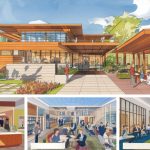Paradigm Shifts in Libraries
Libraries are undergoing a profound transformation, evolving from a focus on physical materials to dynamic hubs for education, learning, collaboration, and community engagement. This evolution demands a re-evaluation of how library services are planned and utilized. We have been thinking about how to synthesize best practices in library space planning for years, drawing heavily from resources like our own Book: Library Space Planning and Design (2025). It is important to recognize trends in user-centered design and adaptive technology integration. Indeed, an iterative process for developing intuitive, pedagogically valuable spaces that support independent education is a successful pathway.
Traditional library planning often began with collection size as the primary driver of space allocation. A more effective approach prioritizes interdependent service planning – understanding how various services interact and influence spatial needs – coupled with a deeply user-centered design methodology. This begins with shifting the fundamental question: not “How much space does our library need?” but “How do our users educate, learn, study, collaborate, and engage with library programs and information?”
Thinking about the future requires us to develop strategies for success.
While user needs take precedence, collection development and user management remains crucial to success. Our book is a guide that will help you emphasizes how to make a library a stage for learning. This means that services can be physical or virtual depending on the program. Often, we start with a thorough assessment of current holdings alongside projected growth over at least a 20 year timeframe. This allows us to start to understand the interdependence between services, spaces, programs and collections.
Interdependent Service Design
Developing intuitive spaces that drive pedagogical value and support independent learning through thoughtful design.
User-Centered Design
Creating service filters based on functional questions about how students study, what they need, and how they use library collections.
Adaptive Technology
Integrating advanced technology and AI solutions while ensuring universal design principles that accommodate diverse learning needs.

Learn More
Case Studies in Modern Library Design
Examining successful library projects offers valuable lessons in design and functionality. The Mount Saint Mary’s Library, nestled into Los Angeles’s hilly topography, exemplifies how historic design can harmonize with modern needs. The beautify of the library and campus weighed heavily on our study. Similarly, the Esperanza College Library in Philadelphia serves a diverse demographic by offering materials in multiple languages and embracing digital technology. The House of Wisdom Library in Sharjah, UAE, beautifully blends modern design with cultural heritage, creating a wonderful library that communicates knowledge and learning skills effectively.
Flexibility and Versatility in Library Spaces
Designing flexible and versatile library spaces is important for accommodating varied educational programs and learning activities. Starting with a basic rectangle, consultants can explore the potential of the space using simple geometry. Movable furniture, modular layouts, and adaptable technology are essential components in creating a dynamic learning environment. As Fraley & Anderson (1990) note, evaluating the general condition of the space, including walls, load-bearing capacity, and floor covering, is vital for functional analysis.
Intercommunication and Collaboration
Effective communication and collaboration are key to successful library development. For example, try involving faculty and staff in service planning discussions. Make sure your team is involved in the discussions enabling them to identify value. Basically, get your team to build cross-functional service workflows. We can do this with AI IDE’s that help us create knowledge through the gathered interactions and knowledge-sharing opportunities. This collaborative approach not only enhances the library’s service program but also ensures that it remains aligned with the community’s needs and expectations.
Complex Interplay
The modern library is a complex interplay of technology, community engagement, and innovative design. Library Development Consultants play a pivotal role in navigating this landscape, ensuring that libraries remain vibrant, relevant, and indispensable community assets.


